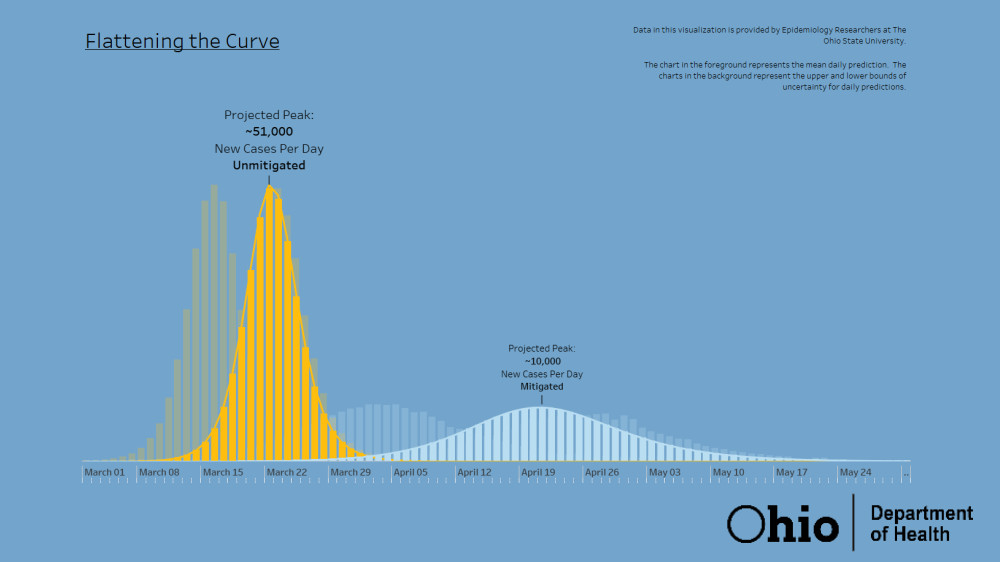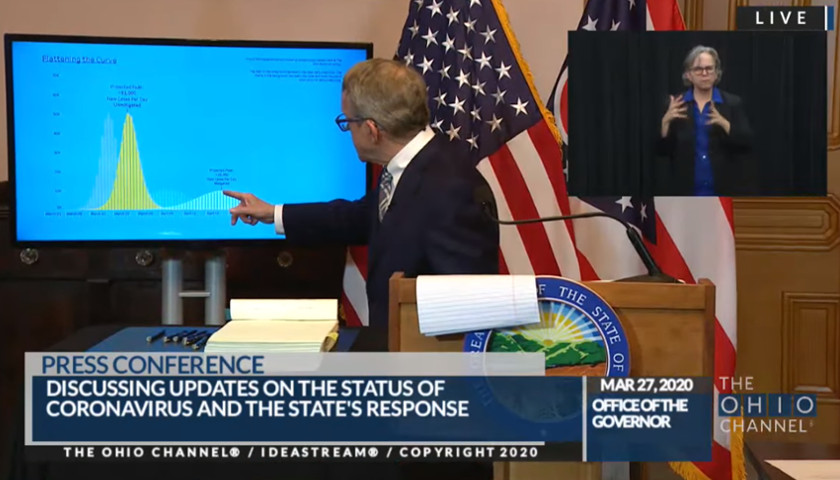Gov. Mike DeWine claimed in a Friday press conference that projections based on a controversial model introduced earlier this month by Ohio Department of Health Director Amy Acton show hospitals in Ohio will be hit hard by the coronavirus in the upcoming weeks.
While the daily increase of confirmed cases of coronavirus in Ohio is undeniable, neither DeWine nor Acton have provided much in the way of factual details related to the methodology of the model, the assumptions and data used in it, or the specific identities of the researchers who have created it.
And some of the claims made by Acton and DeWine about the model’s predictions stretch credulity.
“This is another take on our curves and our graphs,” Acton said at the press conference (at about the 42:43min mark), pointing to a chart on a screen behind her, which is identical to the chart shown below.

“But you can see a shadow – this our unmitigated curve – meaning that if we’d done nothing – if we did not take aggressive, decisive action, but we did, and we’ve made a difference, and we’ve shifted over to the model that we’ve wanted to see,” Acton said, pointing to the place on the light yellow place on the chart slightly to the left of where the graphic Projected Peak –51,000 New Cases Per Day–Unmitigated is seen and directly above the point on the x axis that says March 15. (The darker yellow curve shows that peak at March 22)
“There’s a shadow here that shows every move we have taken has moved the model, and we’re really trying to slow this and steady it. On this y axis curve, we have our cases per day. I know this startled people to say, yesterday, and our model is now showing that at the peak of this curve, we’re now projecting that we may see as many as 10,000 new cases per day,” Acton continued. The chart shows that the blue line reaches a point labeled Projected Peak–10,000 New Cases Per Day–Mitigated on April 19.
The chart used by Acton states that “Data in this visualization is provided by Epidemiology Researchers at the Ohio State University.”
Neither Acton nor DeWine have identified the epidemiology researchers at the Ohio State University who created the model to which Acton and DeWine have based their actions in response to the coronavirus pandemic.
The Ohio Star believes it has identified the Ohio State University researcher behind the model as Professor Grzegorz Rempala, who teaches Biostatistics and who on March 24 delivered a presentation in an online video presented by the Ohio State University Mathematical Biosciences Institute titled “Mathematical Models of Epidemics: Tracking Coronavirus Using Dynamic Survival Analysis.”
During that March 24 online presentation, Rempala said “this is the map that we were asked to produce yesterday for the governor’s office.” [at the 42:38 mark]
The results presented by Rempala of his model appear to be on a par with those presented by Acton on Friday.
“We would see a peak of an epidemic of about 7,000 cases per day in about 30 days. . .10,000 if no social distancing,” Rempala said on the 24th, three days before the Friday press conference from DeWine and Acton.
Notably, Rempala added that disease prevalence is not a factor in his model:
The model is not anticipating or making assumptions about the prevalence [of coronavirus infection] that’s an important distinction and that may be one of the reasons why it leads to slightly different or maybe even widely different predictions than some of those other models some people might have seen. It doesn’t know whether there is a prevalence. It attempts to understand what is the likelihood of having positive confirmed cases among the people who are being tested, and then it, based on those numbers it anticipates what would have been the size of the network from which they are coming.
In a question and answer period, Rempala admitted that he did not have enough information to measure the effects of social distancing in Ohio.
Question: What happens if social distancing is lifted again in May? Does the number of infected shift up to the other curve … and how long will we need social distancing going?
Answer: This model is just attempting to look at the infection curve. We do not have enough information to be able to make such long forward predictions.
It turns out that in this particular representation of the that I am using that in order to be able to tease out some of the social distancing effect, you have to have information about recovery. Because recoveries will tell you sort of about the natural ways in which some of these stop measures are happening.
So once we have more recoveries in Ohio, and in general we have a better distribution of recoveries across the country, we will be able to tease out the social distancing effects much more precisely. And then it might be possible to answer questions like this But certainly not for the next week or two or three.
An epidemiologist with a major national research university who watched the video of Dr. Rempala’s March 24 presentation told The Ohio Star there are several significant problems with the model upon which Gov. DeWine appears to be basing many of his actions in response to the coronavirus pandemic.
“I review research grants that use this sort of modeling approach. When grants doing this are proposed, the review panel always looks for a content expert. There was no infectious disease expert, let alone COVID expert, involved in this,” the epidemiologist said, adding:
The first big problem is this has not been peer-reviewed. Until something like this has gone through extensive expert review, it shouldn’t be treated as gospel truth.
Second, this model makes a few big assumptions. It assumes homogeneity of the population, particularly with respect to the “spread on contact” assumption. I’m not sure that’s valid. There is no accounting of individuals who are exposed and stay negative. Also, it doesn’t incorporate any information about recovery. It basically assumes none have recovered. This is a big deal, because the major hospitals have started drug trials, and are tailoring treatment for different conditions. It also seems that the model is extrapolating based on national trends. Hard to tell though. Lastly, the author even states that his model is limited by the fact that it doesn’t really incorporate the value of negative tests.
Third, you’ll notice that the projections change dramatically with just a few days worth of data. That suggests that individual test-seeking behavior actually biases the model. The projections go from 30,000 to 2 million cases nationally with just a few days worth of data. As the author states repeatedly, it is “too early to tell”. It is possible we are somewhere else on the epidemic curve than his models suggest.
Fourth, this “spread on contact” assumption is huge. It seems to use a single parameter which can’t possibly incorporate all kinds of things that influence whether or not someone acquires infection, things that are really important with COVID in particular. It is pretty well-established that older individuals with pre-existing conditions are much more susceptible. That model doesn’t account for that at all.
UPDATE: In an email exchange with The Ohio Star, Professor Grzegorz Rempala clarified that the study he noted in the video seminar was authored, in part, by Eben Kenah, PhD, whose CV shows he earned a ScD in Epidemiology from the Harvard School of Public Health in 2008. The study’s methodology was peer reviewed.
Despite a questionable scientific basis for his actions, Gov. DeWine has taken a number of aggressive and unprecedented actions to address the coronavirus pandemic in Ohio since he declared a state of emergency on March 10, which allowed state departments and agencies to better coordinate their responses.
On March 14, the governor closed schools and banned mass gatherings of more than 100 people.
On March 15, the Ohio Department of Health stopped reporting coronavirus negative test results to the CDC.
On March 16, the governor ordered all restaurants closed.
Late on the evening of March 16, the governor flouted a judge’s decision and ordered the cancellation of the Ohio presidential primary, an action for which he does not have the Constitutional authority, which was scheduled to begin the following morning, and rescheduled it for June.
On March 22, he issued a statewide “Stay at Home” executive order.
On March 25, the ODH resumed reporting coronavirus negative test results to the CDC.
The number of confirmed coronavirus cases in Ohio has grown from three on March 10, the first day cases were confirmed in the state, to 1,406 as of Saturday March 28. The highest one-day increase in reported cases came on Friday, when 270 new cases were confirmed.
Gov. DeWine began his discussion of the modeling of the growth coronavirus cases in Ohio with a vague conflation of modeling activities he said were being conducted by the Cleveland Clinic with the projections of ODH Director Acton which are, apparently, based on data from “epidemiology researchers” at Ohio State University, a group which The Ohio Star believes is led by Professor Rempala, who is a biostatistician.
“This morning, I had a call from the Cleveland Clinic and they gave us the new information that they have in regard to their modeling and their projections. And I’ll give you the basis of that modelling and what that result was in just a moment,” DeWine said.
“A couple points highlights from what we were told this morning by the Cleveland Clinic in their modeling. First of all, within about two weeks, we will continue to see it go up – in about two weeks we will see it kick in a little harder. And we’re really going to start seeing it very hard in our hospital admissions,” DeWine said, adding:
They project that we may not hit the peak until, now, mid-May. Again, modelling is a science, it’s an art.
But this is the best information – the newest information – that I want to share with you. In addition to that, they are telling us, we need now to look to a two and possible three times build-out of what we have today in our hospital beds, ICU beds.
The Ohio Star contacted the Cleveland Clinic to find out more details about its modeling efforts. Specifically, we wanted to know if their modeling effort is separate and independent from the modeling that has been championed by ODh Director Acton, or if it is, just the same modeling used by OHD, which The Ohio Star believes is likely the modeling provided by Professor Rempala, the Ohio State University biostatistician.
But the Cleveland Clinic offered no additional information. Instead, a spokesperson for the Cleveland Clinic told The Ohio Star that they would be back in touch in the coming days with more information as the organization is still fine-tuning details of the model.
At this point in the press conference, Gov. DeWine pulled what can only be described as a modeling sleight of hand.
Having introduced the idea of modeling and branding it as something associated with the Cleveland Clinic – though offering no specifics as to the model’s projections – he pivoted to the model used by ODH’s Acton based upon some unidentified OSU research (but presumably Dr. Rempala’s) and repeated the same draconian projections Acton has made for the past several weeks.
“The chart up here – this is the chart that Dr. Acton was showing you. Again, this is the projected peak,” DeWine said, as he pointed to the April 19th Projected Peak of 10,000 New Cases Per Day-Mitigated.
“And so, that projected peak [April 19th 10,000 mitigated] if we’re looking at – we need to go up three times in our capacity – it is somewhere in this area here,” DeWine says, pointing at a place in the chart about equal to 3,000 new cases per day on April 19.
Three times – and we really ought to plan for three times. So, as you can see, we have a long way to go.
And that’s the stark reality.
The good news: Hospitals have all been thinking about this, planning for this, and beginning to move forward. And in that regard, we are closing up the planning, and now moving to the action.
DeWine then described his action plan:
We have divided the state up into eight regions, and I have asked each region to have their collective plan on my desk – their draft tomorrow morning.
I have asked General Harris of the Ohio National Guard to oversee this build up.
When asked about President Trump’s proposal of loosening restrictions during the same time the state expects a big upswing in cases, DeWine said that he has tried to use what the best science has told him.
“I can tell you in the phone conversation we had today with some of our hospitals with people who are looking at the modeling that there was a sense of great urgency,” the 73-year-old governor said. “They truly believe this is coming, everything on the graph indicates that it is coming. It is already here.”
Even though Ohio expects a big increase in coronavirus cases, a source told The Star that some hospitals in the state have not experienced cases of COVID-19. Furthermore, this person believes that Acton has been not been entirely truthful about how much of a burden this virus will put on healthcare system in Ohio.
Dr. Deborah Birx, who is the White House coronavirus response coordinator, seems to back this up. On Thursday, she said modeling that shows about 20 percent of a population getting the virus is not based on data the White House has gathered.
Birx added these models “have to have a large group of people who are asymptomatic, who have never presented for any test” to show a large scale of people being infected with COVID-19.
As a state, Ohio has consistently put out numerous coronavirus predictions, which has raised a number of questions. The ODH made the shocking “guesstimate” claim earlier this month that 100,000 Ohioans had the virus due to community spread.
Currently, Ohio said on Saturday that the state would see 8,000 to 10,000 new cases, but just two days ago this number was between 6,000 and 8,000.
“@DrAmyActon: The numbers are a range. I know 8,000-10,000 sounds like a lot, but that really isn’t a huge amount of Ohioans. We want it to spread slower, but it is spreading,” DeWine tweeted. When we stay home, the effectiveness will show up in our data a few weeks from now.”
“It’s complicated, but you don’t have to trust the modeling to see what’s happening in other states,” he added. “We are planning for worst-case scenarios with the hope that everything we do will take us away from that number.”
It's complicated, but you don't have to trust the modeling to see what's happening in other states. We are planning for worst-case scenarios with the hope that everything we do will take us away from that number.
— Governor Mike DeWine (@GovMikeDeWine) March 28, 2020
The governor closed his portion of the press conference by emphasizing the urgency of the situation:
Again: two things we have to do – we’ve got to do them simultaneously. One is the social distancing; one is to slow this thing down. The other is to build up and to build up very, very, very quickly. We do not have a lot of time. The projection is we have two weeks – we’re really going to get slammed in two weeks – and we may not hit the peak until mid-May.
Watch Friday’s press conference here:
– – –
Zachery Schmidt is the digital editor of Star News Digital Media. If you have any tips, email Zachery at [email protected].






Questionable? Ohio is peaking 4/17,18,19 with over a 1,000 cases per day as predicted. The curve has remained flat and we have not seen an overwhelmed hospital system like other states. When Tennessee finally gets up to speed on testing the numbers will jump dramatically and maybe the state will begin taking thie seriously.
[…] previously reported, The Star identified Professor Grzegorz Rempala, who teaches biostatistics at OSU. Rempala said […]
[…] previously reported, The Star identified Professor Grzegorz Rempala, who teaches biostatistics at OSU. Rempala said […]
Thank you for the accurate reporting!! We need more of that in Ohio! Fear Mongering to promote your worth is horrendous!!! Ohio should be ashamed… people are losing their entire life savings because of this!!! We are currently no where near her projections, so she will just keep pushing the projections back!! Thank your for noticing, and thank you for bringing attention to it!!